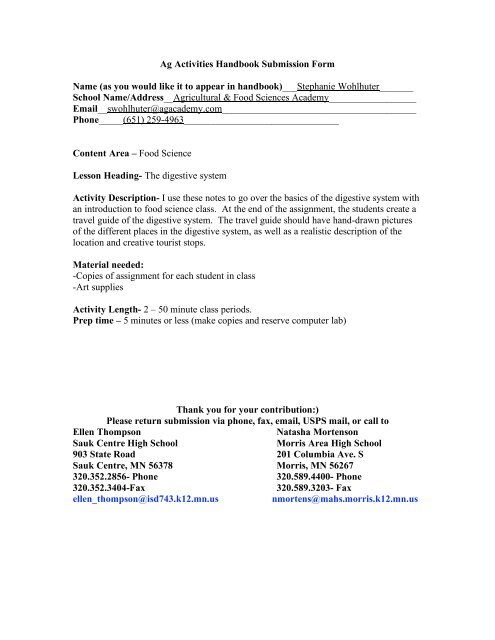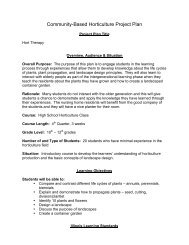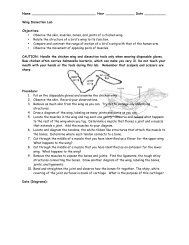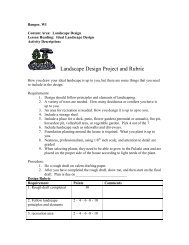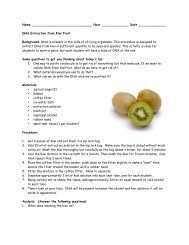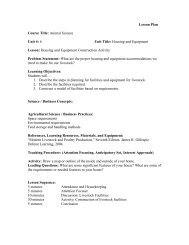Trip Through the Digestive System - Sauk Centre Public Schools
Trip Through the Digestive System - Sauk Centre Public Schools
Trip Through the Digestive System - Sauk Centre Public Schools
Create successful ePaper yourself
Turn your PDF publications into a flip-book with our unique Google optimized e-Paper software.
Ag Activities Handbook Submission FormName (as you would like it to appear in handbook)___Stephanie Wohlhuter_______School Name/Address__Agricultural & Food Sciences Academy__________________Email__swohlhuter@agacademy.com________________________________________Phone_____(651) 259-4963________________________________Content Area – Food ScienceLesson Heading- The digestive systemActivity Description- I use <strong>the</strong>se notes to go over <strong>the</strong> basics of <strong>the</strong> digestive system withan introduction to food science class. At <strong>the</strong> end of <strong>the</strong> assignment, <strong>the</strong> students create atravel guide of <strong>the</strong> digestive system. The travel guide should have hand-drawn picturesof <strong>the</strong> different places in <strong>the</strong> digestive system, as well as a realistic description of <strong>the</strong>location and creative tourist stops.Material needed:-Copies of assignment for each student in class-Art suppliesActivity Length- 2 – 50 minute class periods.Prep time – 5 minutes or less (make copies and reserve computer lab)Thank you for your contribution:)Please return submission via phone, fax, email, USPS mail, or call toEllen ThompsonNatasha Mortenson<strong>Sauk</strong> <strong>Centre</strong> High SchoolMorris Area High School903 State Road 201 Columbia Ave. S<strong>Sauk</strong> <strong>Centre</strong>, MN 56378 Morris, MN 56267320.352.2856- Phone 320.589.4400- Phone320.352.3404-Fax320.589.3203- Faxellen_thompson@isd743.k12.mn.usnmortens@mahs.morris.k12.mn.us
A <strong>Trip</strong> through <strong>the</strong> Gastrointestinal TractOnce food enters <strong>the</strong> mouth, it moves through <strong>the</strong>following process:1. Salivary glands secrete saliva, which contains anenzyme that breaks down starch. Food is moistenedto aid in chewing.2. Mastication (chewing) – increases <strong>the</strong> surface areaof <strong>the</strong> food and mixes saliva enzymes and water with<strong>the</strong> food.3. Esophagus – long tube that serves as <strong>the</strong> fooddelivery mechanism to <strong>the</strong> stomach. It allows us tobrea<strong>the</strong> while chewing by spacing out <strong>the</strong> foodmatter.4. Stomach - contains strong acids, enzymes and fluidsthat mix, toss and grind foods. The pepsin enzymebreaks down bonds found in proteins.5. Small Intestine – The site where actual digestiontakes place. This organ is approximately 20 feet inlength. Specifically, carbohydrates, lipids, andproteins are broken into smaller units here andabsorbed into <strong>the</strong> blood stream.-Pancreas – secretes pancreatic juice and abicarbonate that neutralizes stomach acid thatmakes its way into <strong>the</strong> small intestine..-Gallbladder – stores bile.-Liver - makes bile and digests lipids.6. Large intestine – reabsorbs water and someminerals into <strong>the</strong> blood.7. Rectum – undigested waste is passed here forexcretion.Note: The brain is <strong>the</strong> control center for this wholeprocess. Specifically, <strong>the</strong> hypothalamus regulatesappetite and hunger.
Terms & Definitions• Ingestion – eating and swallowing food and liquids.• Digestion – <strong>the</strong> breakdown of food into itsindividual nutrients.• Absorption – nutrients in contact with <strong>the</strong> cell wallof <strong>the</strong> GI tract for an extended period of time arepassed into <strong>the</strong> cells.• Transportation – nutrients are transported in <strong>the</strong>blood to <strong>the</strong> liver where <strong>the</strong>y are processed and sentto parts of <strong>the</strong> body to use.• Peristalsis – layers of muscles squeeze and push foodalong <strong>the</strong> GI tract.Fun Facts about Digestion• When food goes through <strong>the</strong> process from ingestionto excretion about 24-72 hours have lapsed. If aperson’s diet is high in fiber, that time is reduced.• Why doesn’t <strong>the</strong> stomach digest itself? A substancecalled gastric mucus is made inside <strong>the</strong> body. Thissubstance lines <strong>the</strong> stomach wall so that acids can’teat away at <strong>the</strong> stomach lining.• The liver is an important organ in <strong>the</strong> body. Not onlydoes it “process” nutrients to send to o<strong>the</strong>r parts of<strong>the</strong> body, but it also detoxifies harmful substancesthat are ingested into <strong>the</strong> body. Putting too manyharmful substances into <strong>the</strong> body can cause cirrhosis,or hardening of <strong>the</strong> liver.• The process of peristalsis slows down as humans age,thus increasing <strong>the</strong> risk for constipation.Your assignment:• Create a brochure or small booklet that will serve asa “travel guide” of <strong>the</strong> gastrointestinal tract.
• Your guide should include <strong>the</strong> followingcomponents:o A hand-drawn picture of all seven “locations”in <strong>the</strong> digestive tract.o A physical description of each location.o A creative explanation of interesting features,tour options, restaurants, etc., that can bevisited at each stop.• The emphasis on this assignment will be placed oncreativity. The goal is that you understand each partof <strong>the</strong> digestive tract well enough to createanalogies between it and a real-life location that isknown for tourism.


